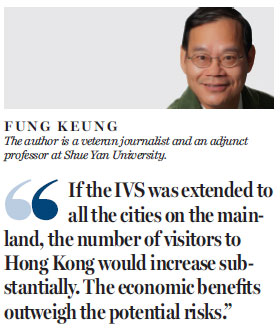Beijing must take bold steps to boost HK's tourism industry
Updated: 2016-03-11 08:04
By Fung Keung(HK Edition)
|
|||||||||
Beijing might consider extending the Individual Visit Scheme (IVS) to all 661 cities on the mainland in order to save Hong Kong's tourism industry.
Beijing's tourism tsars should be encouraged to waste no time in adopting this new measure. Currently, only citizens of 49 mainland cities are allowed to travel to Hong Kong under the IVS. (Other people have to join tours if they want to visit the city.)
Hong Kong's GDP growth slowed to 1.9 percent in January 2016, down from 2.5 percent in January 2015. A drop in tourists to the city has hurt the retail and catering businesses.
The Hong Kong Tourism Board predicts that overall tourist numbers will decline 1.8 percent this year. The number of visitors to the city dropped 2.5 percent last year from 2014. It was the first drop since Hong Kong was hit by the SARS epidemic in 2003.
The number of tourists from the mainland fell 3 percent last year. If the IVS was extended to all the cities on the mainland, the number of visitors to Hong Kong would increase substantially. The economic benefits outweigh the potential risks.
Detractors would argue that if people from the remaining 612 cities were free to travel to Hong Kong individually, it would encourage parallel traders to jump on the opportunity. Parallel traders from Shenzhen across the border created tensions between them and Hong Kong residents over the last few years.
Detractors also fear that parallel traders would clash with Hong Kong's pro-independent "localist" group members. Such potential clashes would tarnish Hong Kong's image and might discourage visitors from other parts of the world. However, they need not worry.
Shenzhen residents now are restricted to visiting Hong Kong only once a week. Shenzhen residents' travel cost to Sheung Shui (a town near Lo Wu) is so low (the train ride takes about 5 minutes) that they can profit from bringing home a can of milk powder.
The case for travelers from other mainland cities is different. Just imagine: A visitor from Chongqing (a few thousand miles from Hong Kong) can easily spend a few thousand Hong Kong dollars in air fares alone. Would he or she aim to purchase milk powder in Hong Kong? Obviously not. Most of them would come to Hong Kong mainly for sightseeing and its good cuisine. Detractors can relax.
Another task Beijing tourism officials can do for Hong Kong is to facilitate its cruise business. The site of Hong Kong's former Kai Tak Airport has a cruise terminal. We can organize cruise trips (for visitors from Asia and other parts of the world) from Hong Kong to mainland coastal cities such as Shanghai, Qingdao, Xiamen and Haikou in Hainan Island.
Hong Kong, however, needs the cooperation of these coastal cities to arrange inland tours for visitors onboard the cruise ships. Without such local tours, the cruise trips would be less attractive, which means less business for Hong Kong's cruise industry. It would be great if Beijing tourism officials could converse with officials in coastal cities to meet requests from Hong Kong's cruise operators.
During the "two sessions" (the National People's Congress and Chinese People's Political Consultative Conference National Committee) in Beijing on March 8, Beijing tourism officials asked their counterparts in Hong Kong to write a report on ways to boost tourism in the SAR. Hong Kong tourism officials are well-advised to include these two points: First, ask Beijing to extend the IVS from 49 cities to the remaining 612 cities; and second, request that Beijing officials liaise with officials in coastal mainland cities to facilitate visits from passengers onboard Hong Kong-based cruise ships. These two measures will go a long way to improving Hong Kong's tourism industry and its struggling economy.

(HK Edition 03/11/2016 page9)